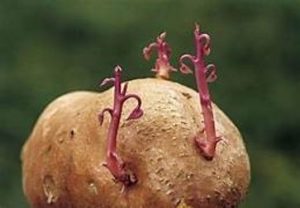By Debbie Roland and
Emmy Ulmschneider
Master Gardeners
The average American eats 125 pounds of potatoes per year. If you love them like most people, we hope this article will help you grow your own. Potatoes are a cool season crop growing best in 61 to 64 Fahrenheit and requiring 20 inches of rain or irrigation to mature. There are many cultivars producing a wide range of colored tubers (the potato is a tuber) and they are classified depending on how long that variety takes to mature. They are an early season crop meaning that now is the time to plant them but keep in mind that the plants and the tubers need to be protected from a late, heavy frost.
You grow potatoes by using pieces from the potato itself that are free of chemicals and look healthy. Alternatively, one can buy small tubers, seed potatoes, that have been started commercially. You can sprout your own seed potatoes by dividing a tuber into pieces about the size of a medium egg with at least one eye or bud. A potato will get buds, commonly called eyes, that sprout and grow into a new plant. This piece will provide food until the plant develops its own root system. Place the pieces in a single layer with the eyes, buds, placed up. When the sprouts from the bud have grown to about 3/4” they are ready to plant.

Potatoes need full sun and very loose soil. If the soil is too heavy or packed the tubers will be small and the numbers will be fewer. To prepare till or spade your soil to a depth of 12”. Potatoes need their fertilizer early in the season so apply a complete fertilizer such as 10-20-10 to your pots or in-ground garden before planting being sure to follow package directions. Next use your hoe to flatten about 1” of the soil over the fertilizer. Then plant your seed pieces 12” apart about 3 weeks before the last frost. You can protect the young shoots from a late, heavy frost by covering them with row cover, straw, or newspaper.
When your plants are about 4” tall reapply fertilizer beside each plant and water in. While your potatoes are growing be sure to keep watering them on a constant schedule. Lack of water then overwatering can cause cracks.
Unless grown under black plastic (not a good idea in our climate), potatoes are commonly hilled. Hilling increases the quality and the yield. Soil is pulled toward the plant as it grows which allows more potatoes to form in the soil and prevents the potatoes from turning green and unpalatable. You can use mulch for this when the plant is 8 to 10” tall.
When the tops of your plant begin to die and the tuber skin firm they are ready to harvest. You can perform a test dig to see if they are ready. If they are, dig under the plant with a shovel or spade being careful not to pierce the tubers. Pull the vine off and let the potatoes dry. Store them in a cool place that has air movement.
If you are more a sweet potato person, be sure to check out this article on our blog: https://www.westtexasgardening.org/blog/search/sweet%20potato
If you have questions, call the AgriLife office in Odessa at 498-4071 or in Midland at 686-4700. Additional information, and our blog for access to past articles, is available at westtexasgardening.org. Click on “Resources.”




